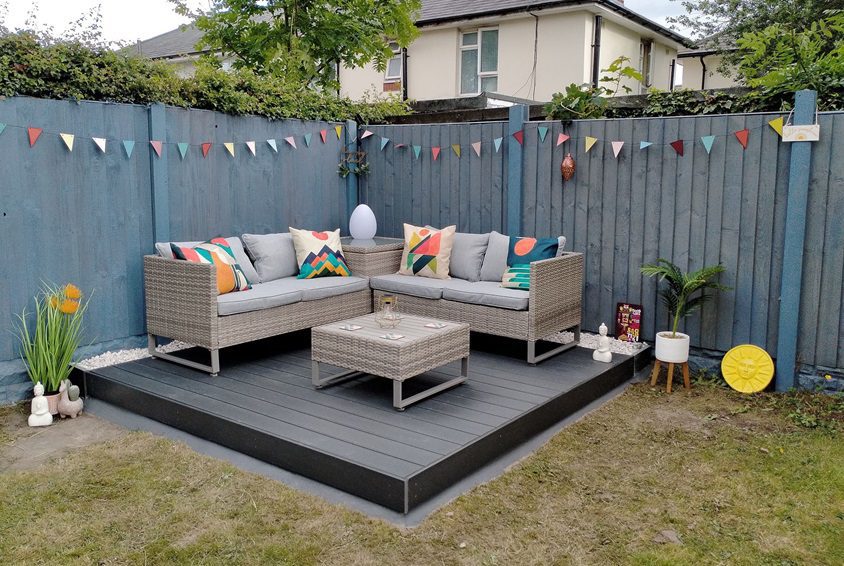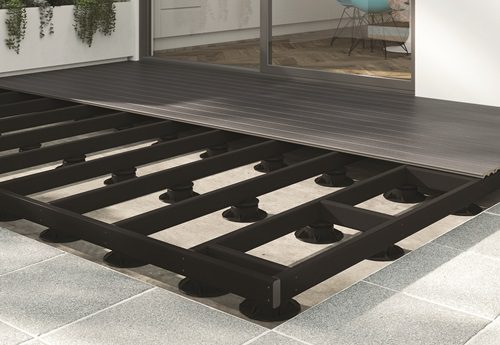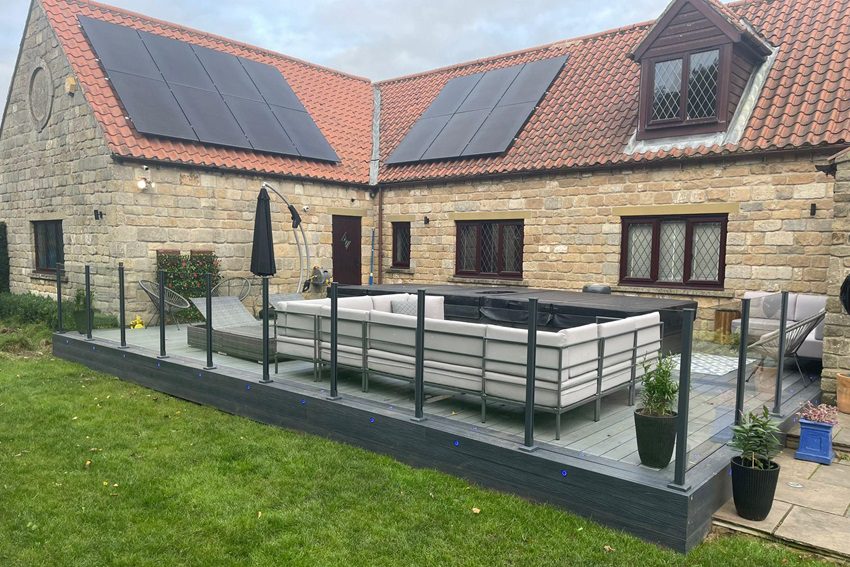Concrete surfaces, such as patios, provide the perfect base for installing composite decking. They’re solid, mostly level, and often carry less moisture than soil. Read on for everything you need to understand about laying composite decking over concrete or a patio, including:
- Benefits of fitting composite decking boards over concrete
- Factors to consider before installing decking over a patio
- How to lay decking over concrete
Let’s get started.
Is building a deck over concrete OK?
In short, yes! You can definitely install composite decking over concrete or on top of an existing stone patio. In fact, there’s several benefits to laying composite decking over a concrete base as opposed to a sand or soil foundation.
Advantages of installing composite decking on concrete
- Quick and easy decking installation
If you install your composite decking on concrete that’s already there, there’s no need to create your own base. So, you’re already saving on time and cost. - Leaves weed worry behind
With a pre-existing concrete base under the composite decking, there’s less chance of weeds and plants growing up between the capped, ribbed and grooved, or wood effect boards once they’re laid. - Less moisture
A concrete base, like a patio, contains less moisture than foundations made from soil or sand. You can feel confident that the joists or support beams and other decking accessories underneath the boards will stay dry. If using a timber frame, it will also help reduce the risk of mould or rot. We’ve got plenty of advice on what to consider when building a base for composite decking and handy tips to prepare your ground for decking. - Refreshes the garden at speed
Whether it’s a garden makeover or an old damaged patio, laying a new composite deck over an existing area of concrete will transform any garden with very little effort. And if you or your customer can’t decide between a patio or decking, why not have both? If the concrete patio is large enough, you can make a composite decking area at one end or corner, while still keeping a patio area for contrast.
Use our insights to help decide between a patio or composite decking: Composite decking VS patio.

Laying decking on concrete: A guide for composite boards
Now you understand the advantages of laying composite decking on concrete slabs, patios, and other areas, there’s a few key considerations to make before starting a garden upgrade for your customer.
Is the ground even or uneven?
Most concrete areas or patios will be slightly uneven or have a slight slope to allow for water run-off. It’s possible to level the surface using a concrete levelling compound, or you can use adjustable pedestals (like in the photo below).

If you’re unsure of the best option, it’s always advisable to talk to an expert, like one of the Ecodek team – contact us!
Has the concrete settled?
If installing composite decking is the sole reason you’re laying concrete (or have already laid concrete), remember it can take a while to settle. Concrete can take up to a year to settle, and it can sink during this time. It’s important to ensure the concrete you’re laying the decking over is completely settled, otherwise you risk the decking foundations sinking and the decking becoming uneven. And no one wants that!
Locations of doors, steps and other features
When laying a composite deck on top of an existing patio or concrete base, the floor level will rise. This may seem obvious, but it’s important to remember as it will affect how the decking meets doors and other features, such as steps – and how you walk from one to the other.
Read our guide to using composite decking for steps for more information on making access to decking easy.
How to build decking over concrete
With these considerations accounted for, it’s onto the fun part – installing the composite decking!
1. Ensure the concrete surface is level
Firstly, you need to make sure the concrete patio or surface is as level as it can be.
2. Install the subframe
You should never install composite decking directly on top of concrete, as the decking needs space for air to flow to ensure good ventilation. So, you need to install a subframe. This frame supports the composite decking boards by giving them rigidity and strength. The subframe also provides flexibility, allowing the deck to move as temperature and weight loads change.
Decking subframe for concrete bases
There are many things to consider when choosing a composite decking subframe material. There are both pros and cons to using timber, composite, or aluminium subframes.
For advice on which material is right for your decking project, read: What base do I need for composite decking?
And when it comes to decking supports, we recommend using adjustable pedestals. You can raise and lower their height to the nearest millimetre, so you can get your joists level for a perfectly level top deck. In an ideal world, use composite joists or beams for a substructure that’s as durable and long-lasting as your deck boards.
3. Lay the decking boards
Lastly, you need to install the decking boards. Simply follow the manufacturer’s instructions and check out our installation guides for more tips, tricks, and support.
We hope these hints and tips will help you on your journey. If you have any questions or would like more guidance about composite decking design and installation, please speak to our friendly, expert team on 01978 667 840.
